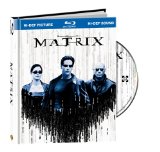| Reviews & Columns |
|
Reviews DVD TV on DVD Blu-ray 4K UHD International DVDs In Theaters Reviews by Studio Video Games Features Collector Series DVDs Easter Egg Database Interviews DVD Talk Radio Feature Articles Columns Anime Talk DVD Savant Horror DVDs The M.O.D. Squad Art House HD Talk Silent DVD
|
DVD Talk Forum |
|
|
| Resources |
|
DVD Price Search Customer Service #'s RCE Info Links |
|
Columns
|
|
|
Matrix: 10th Anniversary Edition Blu-ray Book, The
Warner Bros. // R // March 31, 2009
List Price: $34.99 [Buy now and save at Amazon]
The Film:
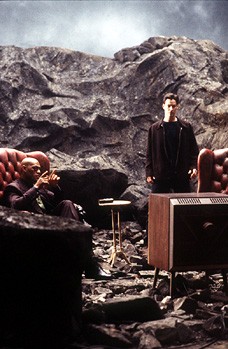 From the moment that we spin around Trinity (Carrie-Anne Moss) in the swirl of newly-fangled "Bullet Time" technology, it's obvious that The Matrix will be a different experience. Once you've reached about twenty minutes into the picture, however, it becomes clear that Larry and Andy Wachowski knew exactly what they were creating with these particular tools in their hands: a breathless, ultra-stylish visual universe with unbeatable action and pocket-size philosophical ponderings, ones that sprawl far beyond the confines of most blockbusters. It condenses high concept, crams in kung-fu fight sequences, dashes in computer-generated realism, and finishes it all off with a gunfight reminiscent of Hard Boiled done by way of Cirque Du Soleil. And it's one of the most watchable pieces of cinema out there because of it.
From the moment that we spin around Trinity (Carrie-Anne Moss) in the swirl of newly-fangled "Bullet Time" technology, it's obvious that The Matrix will be a different experience. Once you've reached about twenty minutes into the picture, however, it becomes clear that Larry and Andy Wachowski knew exactly what they were creating with these particular tools in their hands: a breathless, ultra-stylish visual universe with unbeatable action and pocket-size philosophical ponderings, ones that sprawl far beyond the confines of most blockbusters. It condenses high concept, crams in kung-fu fight sequences, dashes in computer-generated realism, and finishes it all off with a gunfight reminiscent of Hard Boiled done by way of Cirque Du Soleil. And it's one of the most watchable pieces of cinema out there because of it.
Who would've thought that an action/sci-fi/philosophy hybrid directed by the second-time director Wachowskis -- a group of guys who previously assembled a noir-ish tale of deceit featuring Jennifer Tilly and Gina Gershon as lesbian ass-kickers -- would become one of the most influential science fiction films since Blade Runner? Given a large fistful of money more than Bound, still a staggeringly low $60m (one-third that of the modestly-budgeted The Dark Knight), they took their brains into a drastically different direction from their first work and threw together something tremendously memorable. Of course, even while building Bound, they had The Matrix stewing in their minds. The inventive "Bullet Time" technology isn't the greatest draw to tehir creative piece of work, or the martial arts, or the depths of the philosophical collage that they've assembled underneath its narrative. It's in the way that the Wachowskis toss it all together that makes it a triumph, with each element intricately snapped together into something coherent and ridiculously large in scope.
Morpheus (Fishburn) says it best when he offers the "chosen one", Thomas Anderson (Keanu Reeves), his fork in the road: The Matrix is like Alice tumbling down the rabbit hole. Mr. Anderson is introduced to the idea of his reality being nothing but a string of binary code, a mind-altered digital construct called "The Matrix" built to occupy the minds of the world's embryonic population. Instead of continuing his fake, semi-lethargic life as part computer programmer, part moonlighting hacker under the alias Neo, he opts towards learning the truth behind the smoke and mirrors. Reeves, in a very bizarre turn of events, is perfectly cast in the role, making his subtle emotionality coming through his stone-faced disposition one of the film's big assets. After a simple message pops up on his computer screen that says "follow the white rabbit" -- matched by a woman's tattoo he sees minutes later -- he decides to follow suit and begin his descent downwards. We, as well, begin out plummet as we ponder what exactly will happen to him once he's disconnected himself from the mendacity of his surroundings.
Once unplugged from the digital world, Neo learns of the deceitful blanket draped over the modus operandi of the human populace. He's essentially been a battery, power source for once solar-powered machines, since the moment of his birth. The world as he knew it was something akin to a wheel in a hamster's cage, keeping him in motion for the illusion of movement to satisfy inborn urges. Now that he's begun his enlightened path towards being the "chosen one" on Morpheus' pirate hovercraft Nebuchadnezzar, he's to be hunted both in and outside the program by the machines themselves.
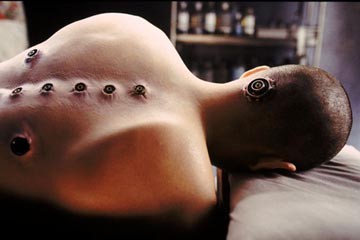 They're given a face as Agents within the digital construct, primarily with the ring leader Agent Smith (Hugo Weaving) as their arch-nemesis. Weaving was, at the time, relatively little known outside of those circles that knew him through Priscilla: Queen of the Desert. That quickly changed, leading him into numerous other roles -- notably as Elrond in the Lord of the Rings films, a perfect fit for the largely theatrical actor. However, his turn here as the villain is magnificent, pouring through sneers and eyebrow shifts that cast piercing glances even through his pitch-black sunglasses.
They're given a face as Agents within the digital construct, primarily with the ring leader Agent Smith (Hugo Weaving) as their arch-nemesis. Weaving was, at the time, relatively little known outside of those circles that knew him through Priscilla: Queen of the Desert. That quickly changed, leading him into numerous other roles -- notably as Elrond in the Lord of the Rings films, a perfect fit for the largely theatrical actor. However, his turn here as the villain is magnificent, pouring through sneers and eyebrow shifts that cast piercing glances even through his pitch-black sunglasses.
Following the bombardment of bullets and explosions surrounding female heroine Trinity at the start, an introduction of sorts to the rhythm that the action sequences will take, The Matrix grows highly dialogue-driven in a smattering of "scorched the sky" sci-fi mythos. We listen to Morpheus verbalizes the history of the earth, introducing the concepts of artificial intelligence conquering the world and humans being compressed underneath its power. There's a lot of content and concepts to process as Fishburn and Reeves toss around almost salesman-like banter selling religion and conceptualization at the beginning, but they all maintain an intriguing feel due to the Wachowskis' grip on tight atmosphere. They also keep a firm hold on the attention span of The Matrix's audience, which is proven by their touch-and-go theoretical revelations throughout.
Instead of keeping a steady battering ram of mindjob concepts, they toss in a healthy dose of John Woo-inspired gunfights and slick martial arts to keep it enthralling on more than just its garbled dystopian level. Choreographed by legendary Hong Kong martial arts expert Yuen Wo-Ping, the battle sequences are frequent and splendid to behold. Especially the training sequence where Morpheus really challenges Neo for the first time; after being "programmed" with an array of martial arts techniques, Neo beings to learn about his new abilities by taking on the sagely master. In that, you also get to see a splash of the humor infused in The Matrix. Lines about dodging bullets and breathing air lift the apocalyptic air sporadically.
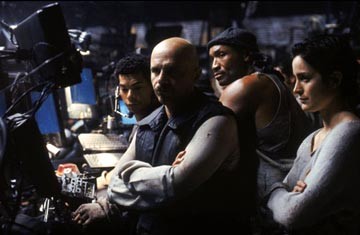 Though religious allegories and political send-ups are easy targets for dissection in The Matrix, most notably the parallels between its script to Existentialism and Jean Baudrillard postmodernism, there's one other "element" that really ties everything together that many might not pay direct attention to. Through austere, green-drenched cinematography that shifts to cold blue in the real world, there's a modicum of partly-symbolic elements scattered throughout. Little details -- like the reflection of Keanu Reeves in Morpheus' sunglasses as he chooses either a red pill or a blue pill -- add to the bleak mise en scene in a way that keep our eyes bouncing around from relic to relic. That's just one example of many; from the near-full glass of water separating Morpheus and Neo at their initial meeting to the flowing of a liquefied mirror onto his skin, it gravitates towards themes of looking deep into optimism, belief, and reflection of one's self.
Though religious allegories and political send-ups are easy targets for dissection in The Matrix, most notably the parallels between its script to Existentialism and Jean Baudrillard postmodernism, there's one other "element" that really ties everything together that many might not pay direct attention to. Through austere, green-drenched cinematography that shifts to cold blue in the real world, there's a modicum of partly-symbolic elements scattered throughout. Little details -- like the reflection of Keanu Reeves in Morpheus' sunglasses as he chooses either a red pill or a blue pill -- add to the bleak mise en scene in a way that keep our eyes bouncing around from relic to relic. That's just one example of many; from the near-full glass of water separating Morpheus and Neo at their initial meeting to the flowing of a liquefied mirror onto his skin, it gravitates towards themes of looking deep into optimism, belief, and reflection of one's self.
Then again, it's also a blast to just throw a bag of popcorn in the mix and indulge in all the visceral action at play underneath The Matrix's science fiction razzle-dazzle. Many years after the fact, the computer-generated artistry still holds up extremely well. Integrating the newly-fangled "Bullet Time" technology, a technique that slows down the flow of time to a snail's pace in order to see a gun shot or Trinity hover crane-style, they somehow add even more tension -- even as the motion comes to a stand still. But that's just the most obvious of examples; each of the special effects, aside from the Sentinels (the robotic creatures that invade pirate ships in the tunnels of the earth), hold surprising tangibility.
The action builds into an explosive conclusion, one that ties the concepts of Neo possibly being "the one" together with a dizzying conflagration of gunfire and martial arts chaos. In a modern cinematic world where the third act is a problematic area, the Wachowski Brothers have really shown how to deliver the goods. Massive momentum is built up about the intensity surrounding Neo's powers and, after a visit to the Oracle that solidifies his destiny, it all comes together into a bombastic rain of fire that delivers the visceral goods pound for pound in a way that closes up shop with the perfect blend of ambiguity and closure. The Matrix may have sparked two sequels -- Reloaded and Revolutions -- but they're nowhere near as well-balanced or enthralling as the original, which stands on its own as a brilliant catalyst for 21st century science fiction.
The Blu-ray:
As a Tenth Anniversary offering, Warner Bros. have put together an attractive standalone edition of The Matrix for those that wish to steer away from the sequels on Blu-ray. Featuring attractive Digibook packaging, it carries a nice holographic sheen and a sturdy build to hold the Blu-ray disc inside.
Video and Audio:
The Matrix has always been something of a demo disc for home theater systems, more for the audio side of things instead of the visuals -- something that differs between it and its sequels. Yet, it usually gets picked from the rotation simply because, well, it's the better film. Here, the Blu-ray handles itself about the same, being just a notch below its higher-budget sequels in the visual department. Presented in its original aspect ratio of 2.4:1 with a nice VC-1 encode, The Matrix still looks incredibly good in 1080p splendor.
After watching the Bitrate a bit, the number rarely spiked any higher than 17 or 18 Mbps. This leads me to believe that it's practically the same transfer that was on the HD-DVD, proven by the fact that they look nearly identical in grain structure and contrast detail -- with maybe, just maybe, a slight improvement in compression. Grain is much more apparent in the original Matrix, mostly due to the lower-grade film stock used. It's a little blurry and a little grainier than you'd expect from a film this recent, but nothing terribly obtrusive. Also, you might spot a hint of edge enhancement in highly-contrast areas, notably against Agent Smith during the interrogation sequence. However, these are cherry-picking negatives off of something that's extremely positive.
Color saturation persistently looks outstanding, rendering the blistering greens of the Wachowskis' new color timing with plenty of saturation. If you haven't purchased a form of The Matrix since the original snapper DVD, you'll notice that the color scheme has been tailored to look more like the second and third films. At any rate, sharpness is handled slickly in a few scenes, namely on deck in the Nebuchadnezzar and in well-lit interior shots. If you've got the HD-DVD, stick with it unless you'd enjoy owning the snazzy book packaging or want all of the special features on one side of the disc; however, if you're still running with the DVD and have Blu-ray capabilities, this is certainly a striking, film-like rendering of the film that's absolutely one of the better Blu-ray offerings.
On the audio side of things, however, we're working with a mammoth of a TrueHD track that doesn't show a lick of budget difference whatsoever. The Matrix is an overwhelmingly active film, filled with gunshots and explosions aplenty along with quieter, delicate sound designs. This track is all about solid mid-range rendering, showcasing a phenomenal sound design that never booms too much or pierces high points too loudly. As to be expected, the balls-out gunfire sequence near the close of the film is an outstanding test sequence -- though, there's quite a few of them on this disc. It makes ample, natural use of the rear channels for effects and musical accompaniment, all while keeping the lower-frequency channel quite active. Vocals ring true throughout the film, never steering towards inaudibility even when they grow a little weaker. A few crashes here and there fall a smidge on the flat side, but that's flat in comparison to its bombastic companion effects. In short, this is an incredible aural treat that's worthy of exercising the limits of any receiver. An English 5.1 Dolby Digital track is also available, which it actually defaults to when the film starts, alongside optional English, French and Spanish subtitles.
Special Features:
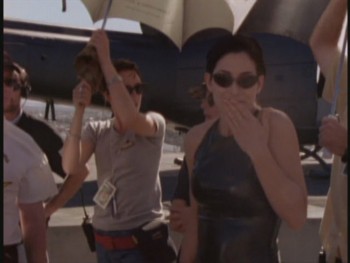 As with the HD-DVD set, The Matrix Blu-ray carries over most of the film-specific features onto the disc. Aside from the "extended" documentaries available as separate discs, there's a wealth of supplements to tear through. Doing the math will net you a value somewhere in the neighborhood of 15 to 16 hours or so, counting all of the commentary tracks. Here's what we've got:
As with the HD-DVD set, The Matrix Blu-ray carries over most of the film-specific features onto the disc. Aside from the "extended" documentaries available as separate discs, there's a wealth of supplements to tear through. Doing the math will net you a value somewhere in the neighborhood of 15 to 16 hours or so, counting all of the commentary tracks. Here's what we've got:
Commentaries:
A staggering four audio commentaries are available for your listening pleasure, each of tehm an absolute blast. First, there's a Philosophers Commentary with Dr. Cornel West and Ken Wilber that tears through symbolism throughout the picture, one that stays a lot more active than you might imagine. Second, Todd McCarthy, John Powers and David Thomson power through a Critic's Commentary, one that stays lighthearted and very cozy with the material. Third, we've got a Cast/Crew Commentary with Carrie-Anne Moss, Zack Steenberg, and John Gaeta that plays out about the way you'd expect after seeing each respective person in The Matrix Revisited documentary (more on that later). Finally, we've got a strong Composer Commentary with Don Davis that also features a Music-Only track to pair with the film. Some surprises can be had in these options, namely the depth of the philosopher's track and the lackadaisical ramblings of the three critics -- and that's meant in a very good way. Also included is the Writter Introduction by the Wachowski Brothers to read before the film begins.
In-Movie Experience:
Essentially, this portion takes raw material from all of the featurettes and puts them in a box during points in the film. Framed in a gray border, the material pops in and causes a bit of a noise disruption each time. Still, it's a dynamic way of getting all of the material from previous editions in a side-by-side manner during the film, like a semi-interactive commentary.
The Matrix Revisited (2:02:51, VC-1 SD):
Fantastically detailed and in-depth, this really is the end-all, be-all of making-of featurette. It literally discusses every aspect of assembling the film, from production design and casting to working in Sydney, Australia. It also goes scene-by-scene and discusses each of them in further detail, namely sequences packed with action. Filled with interview time with the cast and crew as they're working on Reloaded and Revolutions, it's an enormous undertaking to soak in this much Matrix -- thankfully, there are chapter stops.
Behind The Matrix (42:58, MPEG-2 SD):
Where "The Matrix Revisited" found the filmmakers largely on the set of the sequels, this making-of "gallery" features interview time and behind-the-scenes footage while on-set. It discusses many of the same things, though it's in large part around 70-75% behind-the-scenes footage. Though it might seem redundant, there's one reason aside from the material itself to have this one on-hand: it shows clips from the film with the original color timing.
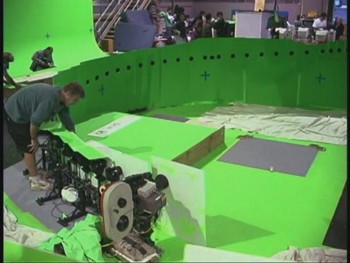 The Music Revisited:
The Music Revisited:
Serving as a track listing for the 30+ songs from the film, it works as a soundboard that can be left on and/or looped for your listening pleasure. While playing, The Matrix coding oozes down the screen.
Follow the White Rabbit (23:01, MPEG-2 SD):
As a neat aside to the "Behind The Matrix" featurettes, this assembly of nine (9) behind-the-scenes footage pieces follows along scene-by-scene and shows how they were constructed. It flows along in near real-time fashion, such as showing a clip of Trinity jumping from building to building in the film and then showing her on the wires atop a green screen.
Take the Red Pill (17:42, MPEG-2 SD):
Closing up the special features is a computer graphics and camerawork portion that discusses "Bullet Time" and the implementation of storyboards and computer-generated imaging to achieve the special effects. It's split into "Bullet Time" and "Concept".
Also available are two Trailers, one teaser and one theatrical, as well as a few TV Spots.
Final Thoughts:
Andy and Larry Wachowski crammed every single idea that they've pondered over their years into The Matrix, which essentially is the product of attempting to make Japanese animation come to life with a philosophical undercurrent. Combining mannerisms from Hong Kong martial arts cinema, John Woo gunplay, the inclusion of a new technology in "Bullet Time" and an overall incredible sense of bleak, dystopian atmosphere, it's without question one of the most potent and re-watchable science fiction films out there. For 130 minutes, it's hard to find a piece of cinema that's as tense, thought-provoking, and electric -- aside from Ridley Scott's Blade Runner.
Warner Brothers' standalone presentation of The Matrix does exactly what fans of the film have wanted for quite some time now: it packs incredible audio/video performance in with a dense array of special features, without being forced to purchase the sub-par sequels. In that, since the Wachowskis' tour de force looks great, sounds incredible, and offers a ridiculously comprehensive array of film supplements, this earns the DVDTalk Collector's Series marker. Finally, a much smaller investment can make this action/sci-fi hybrid available without being skewered into owning the full canon. And, as many know, the original Matrix works splendidly as its own body of work.
Thomas Spurlin, Staff Reviewer -- DVDTalk Reviews | Personal Blog/Site
 From the moment that we spin around Trinity (Carrie-Anne Moss) in the swirl of newly-fangled "Bullet Time" technology, it's obvious that The Matrix will be a different experience. Once you've reached about twenty minutes into the picture, however, it becomes clear that Larry and Andy Wachowski knew exactly what they were creating with these particular tools in their hands: a breathless, ultra-stylish visual universe with unbeatable action and pocket-size philosophical ponderings, ones that sprawl far beyond the confines of most blockbusters. It condenses high concept, crams in kung-fu fight sequences, dashes in computer-generated realism, and finishes it all off with a gunfight reminiscent of Hard Boiled done by way of Cirque Du Soleil. And it's one of the most watchable pieces of cinema out there because of it.
From the moment that we spin around Trinity (Carrie-Anne Moss) in the swirl of newly-fangled "Bullet Time" technology, it's obvious that The Matrix will be a different experience. Once you've reached about twenty minutes into the picture, however, it becomes clear that Larry and Andy Wachowski knew exactly what they were creating with these particular tools in their hands: a breathless, ultra-stylish visual universe with unbeatable action and pocket-size philosophical ponderings, ones that sprawl far beyond the confines of most blockbusters. It condenses high concept, crams in kung-fu fight sequences, dashes in computer-generated realism, and finishes it all off with a gunfight reminiscent of Hard Boiled done by way of Cirque Du Soleil. And it's one of the most watchable pieces of cinema out there because of it. Who would've thought that an action/sci-fi/philosophy hybrid directed by the second-time director Wachowskis -- a group of guys who previously assembled a noir-ish tale of deceit featuring Jennifer Tilly and Gina Gershon as lesbian ass-kickers -- would become one of the most influential science fiction films since Blade Runner? Given a large fistful of money more than Bound, still a staggeringly low $60m (one-third that of the modestly-budgeted The Dark Knight), they took their brains into a drastically different direction from their first work and threw together something tremendously memorable. Of course, even while building Bound, they had The Matrix stewing in their minds. The inventive "Bullet Time" technology isn't the greatest draw to tehir creative piece of work, or the martial arts, or the depths of the philosophical collage that they've assembled underneath its narrative. It's in the way that the Wachowskis toss it all together that makes it a triumph, with each element intricately snapped together into something coherent and ridiculously large in scope.
Morpheus (Fishburn) says it best when he offers the "chosen one", Thomas Anderson (Keanu Reeves), his fork in the road: The Matrix is like Alice tumbling down the rabbit hole. Mr. Anderson is introduced to the idea of his reality being nothing but a string of binary code, a mind-altered digital construct called "The Matrix" built to occupy the minds of the world's embryonic population. Instead of continuing his fake, semi-lethargic life as part computer programmer, part moonlighting hacker under the alias Neo, he opts towards learning the truth behind the smoke and mirrors. Reeves, in a very bizarre turn of events, is perfectly cast in the role, making his subtle emotionality coming through his stone-faced disposition one of the film's big assets. After a simple message pops up on his computer screen that says "follow the white rabbit" -- matched by a woman's tattoo he sees minutes later -- he decides to follow suit and begin his descent downwards. We, as well, begin out plummet as we ponder what exactly will happen to him once he's disconnected himself from the mendacity of his surroundings.
Once unplugged from the digital world, Neo learns of the deceitful blanket draped over the modus operandi of the human populace. He's essentially been a battery, power source for once solar-powered machines, since the moment of his birth. The world as he knew it was something akin to a wheel in a hamster's cage, keeping him in motion for the illusion of movement to satisfy inborn urges. Now that he's begun his enlightened path towards being the "chosen one" on Morpheus' pirate hovercraft Nebuchadnezzar, he's to be hunted both in and outside the program by the machines themselves.
 They're given a face as Agents within the digital construct, primarily with the ring leader Agent Smith (Hugo Weaving) as their arch-nemesis. Weaving was, at the time, relatively little known outside of those circles that knew him through Priscilla: Queen of the Desert. That quickly changed, leading him into numerous other roles -- notably as Elrond in the Lord of the Rings films, a perfect fit for the largely theatrical actor. However, his turn here as the villain is magnificent, pouring through sneers and eyebrow shifts that cast piercing glances even through his pitch-black sunglasses.
They're given a face as Agents within the digital construct, primarily with the ring leader Agent Smith (Hugo Weaving) as their arch-nemesis. Weaving was, at the time, relatively little known outside of those circles that knew him through Priscilla: Queen of the Desert. That quickly changed, leading him into numerous other roles -- notably as Elrond in the Lord of the Rings films, a perfect fit for the largely theatrical actor. However, his turn here as the villain is magnificent, pouring through sneers and eyebrow shifts that cast piercing glances even through his pitch-black sunglasses. Following the bombardment of bullets and explosions surrounding female heroine Trinity at the start, an introduction of sorts to the rhythm that the action sequences will take, The Matrix grows highly dialogue-driven in a smattering of "scorched the sky" sci-fi mythos. We listen to Morpheus verbalizes the history of the earth, introducing the concepts of artificial intelligence conquering the world and humans being compressed underneath its power. There's a lot of content and concepts to process as Fishburn and Reeves toss around almost salesman-like banter selling religion and conceptualization at the beginning, but they all maintain an intriguing feel due to the Wachowskis' grip on tight atmosphere. They also keep a firm hold on the attention span of The Matrix's audience, which is proven by their touch-and-go theoretical revelations throughout.
Instead of keeping a steady battering ram of mindjob concepts, they toss in a healthy dose of John Woo-inspired gunfights and slick martial arts to keep it enthralling on more than just its garbled dystopian level. Choreographed by legendary Hong Kong martial arts expert Yuen Wo-Ping, the battle sequences are frequent and splendid to behold. Especially the training sequence where Morpheus really challenges Neo for the first time; after being "programmed" with an array of martial arts techniques, Neo beings to learn about his new abilities by taking on the sagely master. In that, you also get to see a splash of the humor infused in The Matrix. Lines about dodging bullets and breathing air lift the apocalyptic air sporadically.
 Though religious allegories and political send-ups are easy targets for dissection in The Matrix, most notably the parallels between its script to Existentialism and Jean Baudrillard postmodernism, there's one other "element" that really ties everything together that many might not pay direct attention to. Through austere, green-drenched cinematography that shifts to cold blue in the real world, there's a modicum of partly-symbolic elements scattered throughout. Little details -- like the reflection of Keanu Reeves in Morpheus' sunglasses as he chooses either a red pill or a blue pill -- add to the bleak mise en scene in a way that keep our eyes bouncing around from relic to relic. That's just one example of many; from the near-full glass of water separating Morpheus and Neo at their initial meeting to the flowing of a liquefied mirror onto his skin, it gravitates towards themes of looking deep into optimism, belief, and reflection of one's self.
Though religious allegories and political send-ups are easy targets for dissection in The Matrix, most notably the parallels between its script to Existentialism and Jean Baudrillard postmodernism, there's one other "element" that really ties everything together that many might not pay direct attention to. Through austere, green-drenched cinematography that shifts to cold blue in the real world, there's a modicum of partly-symbolic elements scattered throughout. Little details -- like the reflection of Keanu Reeves in Morpheus' sunglasses as he chooses either a red pill or a blue pill -- add to the bleak mise en scene in a way that keep our eyes bouncing around from relic to relic. That's just one example of many; from the near-full glass of water separating Morpheus and Neo at their initial meeting to the flowing of a liquefied mirror onto his skin, it gravitates towards themes of looking deep into optimism, belief, and reflection of one's self. Then again, it's also a blast to just throw a bag of popcorn in the mix and indulge in all the visceral action at play underneath The Matrix's science fiction razzle-dazzle. Many years after the fact, the computer-generated artistry still holds up extremely well. Integrating the newly-fangled "Bullet Time" technology, a technique that slows down the flow of time to a snail's pace in order to see a gun shot or Trinity hover crane-style, they somehow add even more tension -- even as the motion comes to a stand still. But that's just the most obvious of examples; each of the special effects, aside from the Sentinels (the robotic creatures that invade pirate ships in the tunnels of the earth), hold surprising tangibility.
The action builds into an explosive conclusion, one that ties the concepts of Neo possibly being "the one" together with a dizzying conflagration of gunfire and martial arts chaos. In a modern cinematic world where the third act is a problematic area, the Wachowski Brothers have really shown how to deliver the goods. Massive momentum is built up about the intensity surrounding Neo's powers and, after a visit to the Oracle that solidifies his destiny, it all comes together into a bombastic rain of fire that delivers the visceral goods pound for pound in a way that closes up shop with the perfect blend of ambiguity and closure. The Matrix may have sparked two sequels -- Reloaded and Revolutions -- but they're nowhere near as well-balanced or enthralling as the original, which stands on its own as a brilliant catalyst for 21st century science fiction.
The Blu-ray:
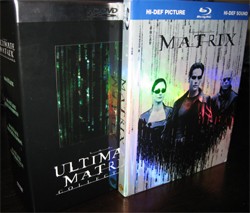 | 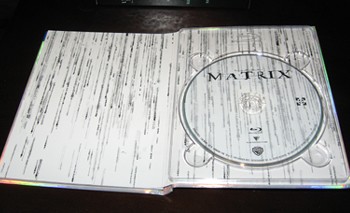 | 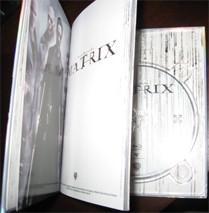 |
As a Tenth Anniversary offering, Warner Bros. have put together an attractive standalone edition of The Matrix for those that wish to steer away from the sequels on Blu-ray. Featuring attractive Digibook packaging, it carries a nice holographic sheen and a sturdy build to hold the Blu-ray disc inside.
Video and Audio:
The Matrix has always been something of a demo disc for home theater systems, more for the audio side of things instead of the visuals -- something that differs between it and its sequels. Yet, it usually gets picked from the rotation simply because, well, it's the better film. Here, the Blu-ray handles itself about the same, being just a notch below its higher-budget sequels in the visual department. Presented in its original aspect ratio of 2.4:1 with a nice VC-1 encode, The Matrix still looks incredibly good in 1080p splendor.
After watching the Bitrate a bit, the number rarely spiked any higher than 17 or 18 Mbps. This leads me to believe that it's practically the same transfer that was on the HD-DVD, proven by the fact that they look nearly identical in grain structure and contrast detail -- with maybe, just maybe, a slight improvement in compression. Grain is much more apparent in the original Matrix, mostly due to the lower-grade film stock used. It's a little blurry and a little grainier than you'd expect from a film this recent, but nothing terribly obtrusive. Also, you might spot a hint of edge enhancement in highly-contrast areas, notably against Agent Smith during the interrogation sequence. However, these are cherry-picking negatives off of something that's extremely positive.
Color saturation persistently looks outstanding, rendering the blistering greens of the Wachowskis' new color timing with plenty of saturation. If you haven't purchased a form of The Matrix since the original snapper DVD, you'll notice that the color scheme has been tailored to look more like the second and third films. At any rate, sharpness is handled slickly in a few scenes, namely on deck in the Nebuchadnezzar and in well-lit interior shots. If you've got the HD-DVD, stick with it unless you'd enjoy owning the snazzy book packaging or want all of the special features on one side of the disc; however, if you're still running with the DVD and have Blu-ray capabilities, this is certainly a striking, film-like rendering of the film that's absolutely one of the better Blu-ray offerings.
On the audio side of things, however, we're working with a mammoth of a TrueHD track that doesn't show a lick of budget difference whatsoever. The Matrix is an overwhelmingly active film, filled with gunshots and explosions aplenty along with quieter, delicate sound designs. This track is all about solid mid-range rendering, showcasing a phenomenal sound design that never booms too much or pierces high points too loudly. As to be expected, the balls-out gunfire sequence near the close of the film is an outstanding test sequence -- though, there's quite a few of them on this disc. It makes ample, natural use of the rear channels for effects and musical accompaniment, all while keeping the lower-frequency channel quite active. Vocals ring true throughout the film, never steering towards inaudibility even when they grow a little weaker. A few crashes here and there fall a smidge on the flat side, but that's flat in comparison to its bombastic companion effects. In short, this is an incredible aural treat that's worthy of exercising the limits of any receiver. An English 5.1 Dolby Digital track is also available, which it actually defaults to when the film starts, alongside optional English, French and Spanish subtitles.
Special Features:
 As with the HD-DVD set, The Matrix Blu-ray carries over most of the film-specific features onto the disc. Aside from the "extended" documentaries available as separate discs, there's a wealth of supplements to tear through. Doing the math will net you a value somewhere in the neighborhood of 15 to 16 hours or so, counting all of the commentary tracks. Here's what we've got:
As with the HD-DVD set, The Matrix Blu-ray carries over most of the film-specific features onto the disc. Aside from the "extended" documentaries available as separate discs, there's a wealth of supplements to tear through. Doing the math will net you a value somewhere in the neighborhood of 15 to 16 hours or so, counting all of the commentary tracks. Here's what we've got: Commentaries:
A staggering four audio commentaries are available for your listening pleasure, each of tehm an absolute blast. First, there's a Philosophers Commentary with Dr. Cornel West and Ken Wilber that tears through symbolism throughout the picture, one that stays a lot more active than you might imagine. Second, Todd McCarthy, John Powers and David Thomson power through a Critic's Commentary, one that stays lighthearted and very cozy with the material. Third, we've got a Cast/Crew Commentary with Carrie-Anne Moss, Zack Steenberg, and John Gaeta that plays out about the way you'd expect after seeing each respective person in The Matrix Revisited documentary (more on that later). Finally, we've got a strong Composer Commentary with Don Davis that also features a Music-Only track to pair with the film. Some surprises can be had in these options, namely the depth of the philosopher's track and the lackadaisical ramblings of the three critics -- and that's meant in a very good way. Also included is the Writter Introduction by the Wachowski Brothers to read before the film begins.
In-Movie Experience:
Essentially, this portion takes raw material from all of the featurettes and puts them in a box during points in the film. Framed in a gray border, the material pops in and causes a bit of a noise disruption each time. Still, it's a dynamic way of getting all of the material from previous editions in a side-by-side manner during the film, like a semi-interactive commentary.
The Matrix Revisited (2:02:51, VC-1 SD):
Fantastically detailed and in-depth, this really is the end-all, be-all of making-of featurette. It literally discusses every aspect of assembling the film, from production design and casting to working in Sydney, Australia. It also goes scene-by-scene and discusses each of them in further detail, namely sequences packed with action. Filled with interview time with the cast and crew as they're working on Reloaded and Revolutions, it's an enormous undertaking to soak in this much Matrix -- thankfully, there are chapter stops.
Behind The Matrix (42:58, MPEG-2 SD):
Where "The Matrix Revisited" found the filmmakers largely on the set of the sequels, this making-of "gallery" features interview time and behind-the-scenes footage while on-set. It discusses many of the same things, though it's in large part around 70-75% behind-the-scenes footage. Though it might seem redundant, there's one reason aside from the material itself to have this one on-hand: it shows clips from the film with the original color timing.
 The Music Revisited:
The Music Revisited: Serving as a track listing for the 30+ songs from the film, it works as a soundboard that can be left on and/or looped for your listening pleasure. While playing, The Matrix coding oozes down the screen.
Follow the White Rabbit (23:01, MPEG-2 SD):
As a neat aside to the "Behind The Matrix" featurettes, this assembly of nine (9) behind-the-scenes footage pieces follows along scene-by-scene and shows how they were constructed. It flows along in near real-time fashion, such as showing a clip of Trinity jumping from building to building in the film and then showing her on the wires atop a green screen.
Take the Red Pill (17:42, MPEG-2 SD):
Closing up the special features is a computer graphics and camerawork portion that discusses "Bullet Time" and the implementation of storyboards and computer-generated imaging to achieve the special effects. It's split into "Bullet Time" and "Concept".
Also available are two Trailers, one teaser and one theatrical, as well as a few TV Spots.
Final Thoughts:
Andy and Larry Wachowski crammed every single idea that they've pondered over their years into The Matrix, which essentially is the product of attempting to make Japanese animation come to life with a philosophical undercurrent. Combining mannerisms from Hong Kong martial arts cinema, John Woo gunplay, the inclusion of a new technology in "Bullet Time" and an overall incredible sense of bleak, dystopian atmosphere, it's without question one of the most potent and re-watchable science fiction films out there. For 130 minutes, it's hard to find a piece of cinema that's as tense, thought-provoking, and electric -- aside from Ridley Scott's Blade Runner.
Warner Brothers' standalone presentation of The Matrix does exactly what fans of the film have wanted for quite some time now: it packs incredible audio/video performance in with a dense array of special features, without being forced to purchase the sub-par sequels. In that, since the Wachowskis' tour de force looks great, sounds incredible, and offers a ridiculously comprehensive array of film supplements, this earns the DVDTalk Collector's Series marker. Finally, a much smaller investment can make this action/sci-fi hybrid available without being skewered into owning the full canon. And, as many know, the original Matrix works splendidly as its own body of work.
|
| Popular Reviews |
| Sponsored Links |
|
|
| Sponsored Links |
|
|
| Release List | Reviews | Shop | Newsletter | Forum | DVD Giveaways | Blu-Ray | Advertise |
|
Copyright 2024 DVDTalk.com All Rights Reserved. Legal Info, Privacy Policy, Terms of Use,
Manage Preferences,
Your Privacy Choices | |||||||









